Science : Term 2 Unit 4 : Cell Biology
Evaluation
I. Choose the correct answer
1. Basis unit of life.
a. Cell
b. Protoplasm
c. Cellulose
d. Nucleus
Answer: A) Cell
2. I am the outer most layer of an animal cell. Who am I?
a. Cell wall
b. Nucleus
c. Cell membrane
d. Nuclear membrane
Answer: C) Cell membrane
3. Which part of the cell is called the brain of the cell?
a. Lysosome
b. Ribosome
c. Mitochondria
d. Nucleus
Answer: D) Nucleus
4. _______ helps in cell division
a. Endoplasmic reticulum
b. Golgi complex
c. Cnetriole
d. Nucleus
Answer: C) Centriole
5. Suitable term for the various components of cell is____
a. Tissue
b. Nucleus
c. Cell
d. Cell organelle
Answer: D) Cell organelle
II Fill in the Blanks
1. The jelly like substance present in the cell is called cytosol.
2. I convert the Sun’s energy into food for the plant. Who am I? chloroplast.
3. Mature Red blood cell do not contain a nucleus.
4. Unicellular organisms can only be seen under a microscope.
5. Cytoplasm plus nucleoplasm is equal to protoplasm.
III. True or False – If false give the correct answer
1. Animal cells have a cell wall. (False)
Animal cells don’t have a cell wall. They have only cell membrane.
2. Salmonella is a unicellular bacteria. (True)
3. Cell membrane is fully permeable (False)
Cell membrane is selectively permeable.
4. Only plant cells have chloroplasts. (True)
5. Human stomach is an organ. (True)
6. Ribosomes are small organelles with a membrane. (True)
IV. Match the following
1. Transporting channel – Nucleus
2. Suicidal bag – Endoplasmic reticulum
3. Control room – Lysosome
4. Power house – Chloroplast
5. Food producer – Mitochondria
Answer
1. Transporting channel – Endoplasmic reticulum
2. Suicidal bag – Lysosome
3. Control room – Nucleus
4. Power house – Mitochondria
5. Food producer – Chloroplast
V. Analogy
1. Bacteria : microorganism :: mango tree : macroscopic organism
2. Adipose : tissue :: eye : organ
3. Cell wall : plant cell :: centriole : animal cell
4. Chloroplast : photosynthesis :: mitochondria : cellular respiration
VI. Choose the correct alternative from the following
1. Assertion (A) : Tissue is a group of dissimilarcells.
Reason (R) : Muscle is made up of Musclecell.
a). Both A and R are true
b). Both A and R are false
c). A is true but R is false.
d). A is false but R is true.
Answer: d). A is false but R is true.
2. Assertion (A) : Majority of cells cannot beseen directly with naked eye because.
Reason (R) : Cells are microscopic.
a). Both A and R are true
b). Both A and R are false
c). A is true but R is false.
d). A is false but R is true.
Answer: d). A is false but R is true.
VII. Very short answer
1. What are the functions of cell wall in plant cell?
Plant cells have a cell wall around the cell membrane that is rigid. It maintains the shape of the cell. It provides support and protection to the cell content.
2. Which organelle uses energy from sunlight to make starch?
Chloroplasts in plant cells use energy from sunlight to make starch.
3. What are the main things in a nucleus?
Plant and animal cells have a nucleus inside the cytoplasm. It is surrounded by a nuclear envelope. One or two nucleolus and the chromatin body are present inside the nucleus.
4. What does cell membrane do?
Cell membranes are selectively permeable. They only allow certain substances to pass in and out of the cell.
5. Why lysosomes are known as scavengers of the cell?
Lysosomes are the main digestive compartments of the cell. They lyse (cause destruction and dissolution to) a cell. As they dissolve, destroy and digest old cells they are called scavengers of the cell.
6. Teacher said “A virus is not an organism” Do you agree with this statement or not? Explain Why?
(a) Viruses are not made out of cells. They can’t keep themselves in a stable state. They don’t grow. They can’t make their own energy. They are more *android than real living organisms.
(b) Living things maintain *homeostasis. They have different levels of organization. Living things grow and reproduce living things. They use energy and respond to stimuli. They adapt to their environment. As these characteristics are absent in a virus, it is not regarded as an organism.
(*homeostatis – maintenance of metabolic equilibrium).
(*android – robots like human beings)
VIII. Give short Answer
1. Why the cell is very important for us?
Cells are the basic structural and functional units of all living organisms. All living things like plants and animals have cells. Without cells we cannot live. So the cell is very important for us.
2. Distinguish between the following pairs (i) Smooth ER and Rough ER (ii) Cell wall and cell membrane (iii) Chloroplast and mitochondria
(i) Smooth Endoplasmic Reticulum has no ribosomes. It produces lipids and steroids and transports them within the cell.
Rough Endosplasmic Reticulum has ribosomes. So it remains rough. It helps in the synthesis of protein.
(ii) Cell wall and cell membrane : All cells have an outer covering called cell membrane. But only plants have cell wall in their cells. Owing to this cell wall plants have a much more regular and rigid shape.
(iii) Chloroplast and mitochondria Chloroplasts are green organelles found only in the cells of plants. They produce food from the Sun’s energy. Mitochondria are round or oval shaped organelles. They are responsible for cellular respiration which releases energy from the food.
3. Write correct sequence from cell to organism?
Cell → Tissue → Organ → Organ system → Organism
4. Write a short note on nucleus.
All plant and animal cells have a nucleus inside the cytoplasm. The nucleus is surrounded by a nuclear envelope. One or two nucleolus and the chromatin body are present inside the nucleus. The nucleus is responsible for the inheritance of character from one generation to another. It controls all the processes inside the cell and it is called the “brain” of the cell.
5. Classify the following terms into cells, tissues, organs and write in the tabular column given below
Neuron, Lungs. Xylem, brain, adipose, Leaf, RBC, WBC, hand, muscle, heart, ovum, squamous, phloem, cartilage.
Cell : Neuron, RBC, WBC, Ovum,
Tissue : Xylem, Adipose , Muscle , Squamous, Phloem, Cartilage
Organ : Lungs, Brain, Leaf, Hand, Heart
6. On the lines given below, write about what you have learned from the activities done in this lesson.
Let me tell you about some of the important things I’ve learned about cells. First, I’ll start with…
IX. Give long answer
1. Write about any three organelles in detail.
Golgi Complex
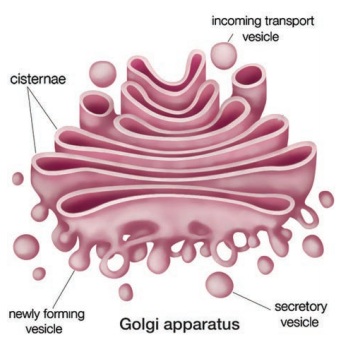
Membrane-bounded sacs are stacked on top of one another with associated secretory vesicles. They are collectively known as golgi complex. Functions of golgi complex are the production of secretory substances, packaging and secretion. This is the secret behind the change in the colour and taste of fruits.
Lysosome – “ suicidal bag”.
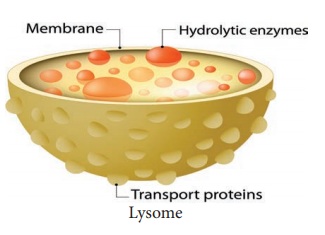
Lysosomes are very small to view using a light microscope. They are the main digestive compartments of the cell. They destroy and dissolve the cells. As they lyse a cell they are called “suicidal bag’’.
Centrioles:
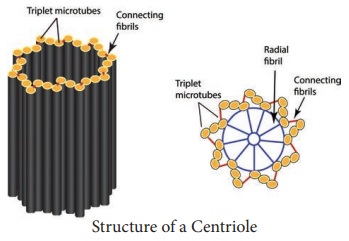
They are generally found close to the nucleus and are made up of tube-like structures.
Centrioles or centrosomes are present only in animal cells and absent in plant cells. They help in the separation of chromosomes during cell division.
2. In a situation, how to explain, while your friend ask what is this, never seen before?
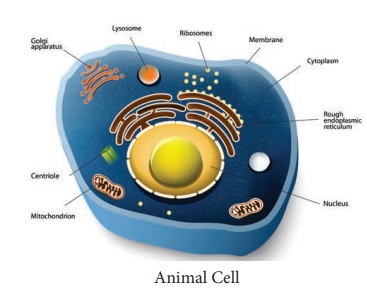
1. Membrane – It is a plasma membrane. It forms the boundary of an animal cell.
2. Cytoplasm – The fluid in a cell outside the nucleus is called cytoplasm. It contains cell organelles.
3. Rough Endoplasmic Reticulum : It is a membranous net work in cytoplasm. It is rough due to the presence of ribosomes. It helps in the synthesis of protein.
4. Nucleus : All cells have nucleus inside the cytoplasm. It is surrounded by a nuclear envelope. It controls all the processes and chemical reactions that takes place inside the cell.
5. Mitochondrian – It is the powerhouse of the cell. It is responsible for cellular respiration which releases the energy from the food.
6. Centriole : It is a pair of minute cylindrical structure. It is involved in the process of cell division.
7. Golgi apparatus : It is a complex of vesicles and folded membranes. It is involved in secretion and intracellular transport.
8. Lysosome : Lysosomes are very small. They are main digestive compartments of the cell. A lysosome is called the suicidal bag.
9. Ribosomes : They are minute particles consisting of RNA. They synthesize polypeptides and proteins.
3. Compare the plant cell and the animal cell and complete the illustration given below.
Animal cell
Cell membrane
Centrioles
Mostly round cells
Plant cell
Cell wall
Chloroplast
Mostly rectangular cells
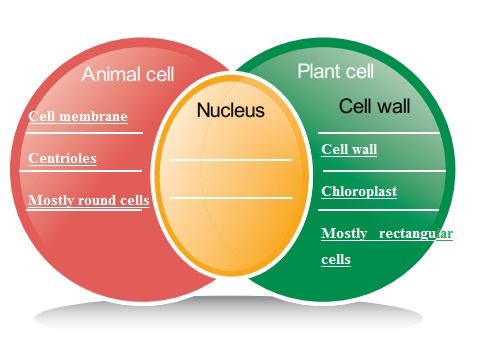
X. Higher order thinking question
Virus is called Acellular. Why?
Viruses are not built up out of cells. They are ‘cell free’. So they are called acellular.
Student Activities
ACTIVITY 1
Do you remember the lesson studied in previous class, how will you find whether on object is living or non – living? Write it down. An object is living or non – living?
1. Form a team and work together to write down some of the functions of life, which you can remember.
Respiration, Digestion, Absorption, Reproduction.
2. Do you think that an individual cell is living? Explain your answer
Living cells breathe. They take food. They also reproduce.
3. Write about various organelles of a cell which you know.
Chloroplast, Mitochondria, Lysosome, Endoplasmic reticulum, Nucleus.
ACTIVITY 2
Find out major organs that are part of the circulatory system of a human body and listout their functions
Heart – It pumps out blood.
Auricles – Upper chambers of the heart
Ventricles – Lower chambers of the heart
Arteries – They carry oxygenated blood to different parts of the body.
Veins – They carry oxygen-poor blood back from the body to the heart
Capillaries – They bring nutrients and oxygen to the tissues and remove waste products from the tissues.
Lungs – The alveoli in lungs purify the blood by supplying oxygen and removing CO2 from blood.
ACTIVITY 3
Study the pictures given and write the differences between cells that you observe in the given table.
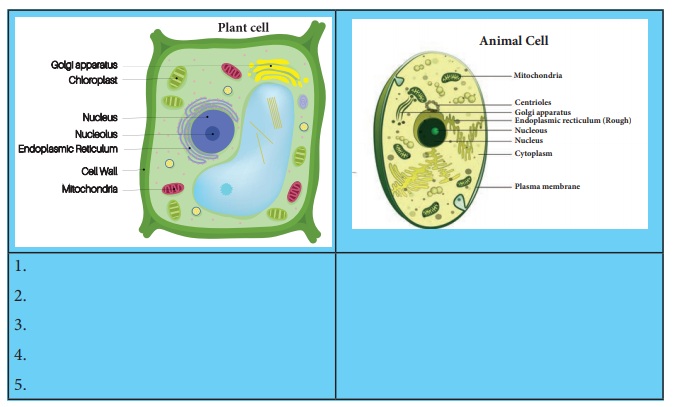
Plant cell
1. Plant cell has a cell wall.
2. It has chloroplast.
3. Centrioles absent
4. One large central vacuole
5. Lysosome usually not evident. Cilia absent in most plant cells.
Animal cell
1. Animal cells do not have a cell wall.
2. Does not contain chloroplast.
3. Centrioles present.
4. One or more small vacuoles.
5. Lysosomes occur in cytoplasm. Cilia is present.
Stem Cells
Stem cells are quite amazing as they can divide and multiply while at the same time with their ability to develop into any other type of cell. Embryonic stem cells are very special as they can become absolutely any type of cell in the body, for example, blood cell, nerve cell, muscle cell or gland cell. So they are utilized by the Scientist and Medicos, to cure and prevent some diseases like Spinal cord injury.
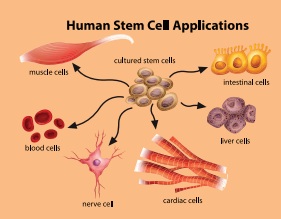
Observing chloroplast in algae
Collect some algae from pond and separate out thin filaments of them. Place a few filaments on a slide. Observe it under the microscope. Take the help of given figure and draw the picture of chloroplast that you have observed under the microscope. Chloroplast is a type of plastid. which are present only in plant cells. Plastids are mainly of two types chromoplasts (coloured) and leucoplasts (colourless).
Various range of these plastids impart different colours to various parts of plant. Chromoplast impart colour to flower and fruits. As fruits ripen, chloroplasts change to chromoplasts. Starch is converted to sugar.
ACTIVITY 4
Summarise what you have learnt
Now you’ve studied the internal structure of a cell. Let us summerise what we have learnt so far Complete this table by filling the main function of each of the cell structures
Cell Structure Function(s) – Function(s)
1. Cell membrane – Allows certain substances to pass in and out of the cell.
2. Cell wall – Provides a frame work for support and stability.
3. Cytoplasm – Area of movement of cell organelles.
4. Mitochondrion – Responsible for cellular transpiration and it releases energy from the food
5. Vacuole – Contains organic and inorganic molecules along with water to support the organelles.
6. Chloroplast – Produces food from sun’s energy.
7. Endoplasmic reticulum – Produces protein, lipids and steroids and transports them within the cell.
Red blood cells
Red blood cells do not contain a nucleus. Without a nucleus, these cells die quickly; about two million red blood cells die every second! Luckily, the body produces new red blood cells every day.
















nice
nice I learnt everything before the teacher finishes the lesson and now I am the second class topper